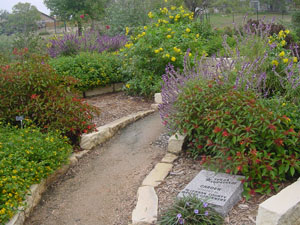Landscape Planning and Design
Landscape planning and design is essential to water use
efficiency and is a common practice in new commercial and in some new residential development. Good design principles make use of existing contours, soil properties and plant materials to reduce the use of supplemental irrigation
and to control stormwater runoff. Good landscape design incorporates the
use of hardscape (sidewalks, porches, patios, and decorative borders) with
the impacts on water use in mind. The proper approach can marry the goals
of efficient water use with water quality. Further, the use of rainwater
catchment can replace the use of potable water in irrigation and in some
cases include air conditioning condensate in a site's water budget
as on alternative source of water.
Successful landscape water conservation practices in Texas
have included programmatic approaches such as educational brochures and workshops,
landscape conversion incentive programs, and ordinance approaches including – landscape
ordinances requiring submission of a landscape design with specific provisions
for trees, irrigation systems, and stormwater interception.
The Texas statewide licensed irrigator requirements assist
in the implementation of good irrigation system design. However as of the
writing of the 1st edition of the Urban Landscape Guide there is no statewide
enforcement and compliance mechanism. Local compliance activities are needed
to ensure that licensed irrigators are used in irrigation system design.
This can be accomplished through the building permit and inspection process
when desired.
Landscape design can take advantage of terrain, soil types, shade and water
sources to get the most out of water efficiency.
- Plants with similar water needs should be grouped together.
- "Thirsty" plants (those with high water requirements) should be placed at the bottom of slopes, in the shade,
and be moved to alternative sources of water like rainwater systems catchment
or graywater systems.
- Use terraces or barriers to minimize runoff.
- Plant ground covers and low water use turfs on slopes.
- Use pervious hardscape or mulch materials to minimize runoff, and ensure
that rainfall replenishes the soil water reservoir
- Place the most drought tolerant plants in southern or western
facing portions of the landscape which tend to be hottest, and driest.2
|
|
"Landscape planning and design is essential to water use efficiency..."

Click to enlarge in separate window. |
|





